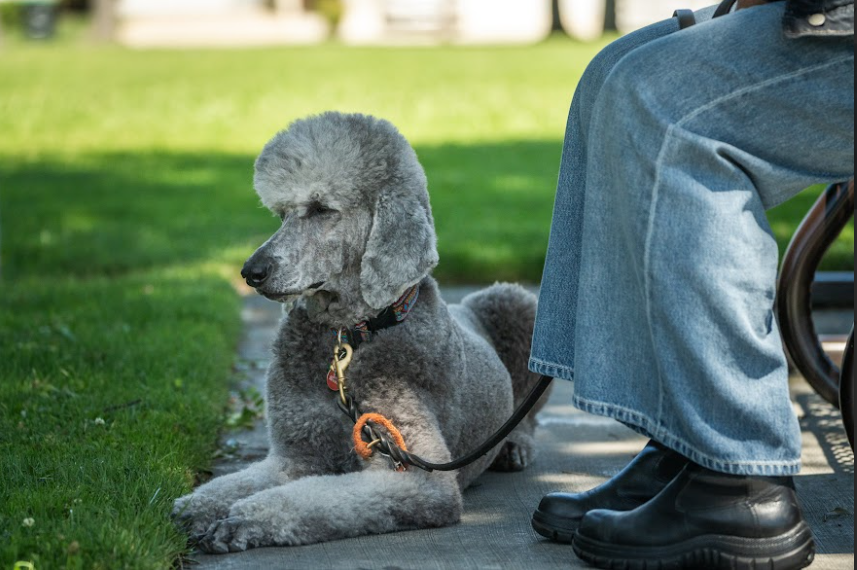6 Tips to Keep Your Dog Safe from the Summer Heat
The cool temperatures of spring will soon be a memory as summer’s heat brings heavy air and spiking temperatures. We humans know what to do when summer comes – get a cool drink, sit in the shade, slather on some sunscreen or just stay inside and turn the air conditioner up. But what about our dogs? They look to us to protect them from the health-related risks soaring summer temperatures bring.
How hot is too hot for your dog?
Generally, at temperatures above 89° Fahrenheit, most dogs are at risk of heat stroke – avoid taking Princess out when it gets that hot. For many dogs, outdoor activity at temperatures above 80° Fahrenheit can be dangerous, and for some dogs even temperatures higher than 70° can be too hot. Play it safe for your dog’s best protection from the heat!
Man in Wheelchair with a Small White Dog (Image Courtesy: MobilityDog.org)
6 Tips to Protect Dogs from Heat Distress
Below are six tips for keeping your pooch cool and safe on those frying-pan summer days.
Provide access to plenty of shade and ample fresh water.
We know that dogs cool themselves through panting and hydration. Make sure your pet has plenty of access to shade and cool water. Change the water frequently to keep it cool (especially if you use a metal bowl) and clean of any summer bugs.
Check the temperature of the pavement before you walk your dog.
If the pavement is uncomfortable for your hands and feet, it will be too hot for your dog’s pads. Test concrete and asphalt with the back of your hand – if you can’t keep your hand comfortably on the surface for 10 seconds, it will also be intolerable for Princess. Also watch out for artificial turf – it looks like grass but can be as hot as concrete.
Gray Service Mobility Dog Sitting in the Cooler Shade (Image Courtesy: MobilityDog.org)
Limit outdoor exertion.
Limit exercise time and intensity when temperatures rise. Don’t trust your pup to signal when she’s had enough – some dogs will stop playing fetch when they’re hot and tired, but others (especially young dogs) don’t know their limits. When it gets hot, move the fun indoors, with a game of inside fetch or hide-and-seek with treats.
Be aware of your dog’s specific heat vulnerabilities.
Typically, small dogs can tolerate higher temperatures than their larger cousins, but there are exceptions:
A dog of any size that is obese, very young or elderly may be especially vulnerable.
Brachycephalic (blunt-faced) breeds will have a harder time in the heat because their short snouts make panting difficult.
Also, dogs with heavy or dark-colored coats may overheat quickly.
Watch for signs of heat distress.
Heat stroke (hyperthermia) occurs when a dog cannot effectively dissipate excess heat. Usually characterized by a body temperature of 106° or higher, symptoms include:
Heavy panting.
Rapid heart rate.
Red gums.
Excessive drooling.
Your dog may also look limp and droopy as though extremely tired.
Heat stroke is a medical emergency! Safe and slow, controlled reduction of body temperature is the priority.
Get the dog into the shade immediately.
Cool water (not cold – no ice cubes or ice water, which may cause stomach distress) may be poured over the head, stomach, armpits and feet.
Cool cloths may be applied to these areas but need to be continually replaced, as they can retain heat and worsen your dog’s condition.
Ensure a continuous flow of air across the dog to help increase evaporative heat loss until treatment at your veterinary hospital.
NEVER leave your dog in the car
This applies regardless of temperature – don’t do it, not even for “just a few minutes” on what seems like a balmy day. Temperatures inside a car rise quickly. Even on a 70° day, temperatures in the car can rise to more than 100° in 30 minutes! If the temperature is 80° outside, it will increase to 99° inside the car in about 10 minutes. Your car is an oven on wheels – don’t let your dog cook inside.
Brown Goldendoodle Sitting on the Grass Staying Cool in the Shade (Image Courtesy: MobilityDog.org)
Summer is a great time to have fun with your canine buddy! Just make sure you take all the necessary precautions to ensure that your pet stays cool and comfortable as you take advantage of the summer weather.




